Lessons from Exportable Combat Training Center Rotation 14-02
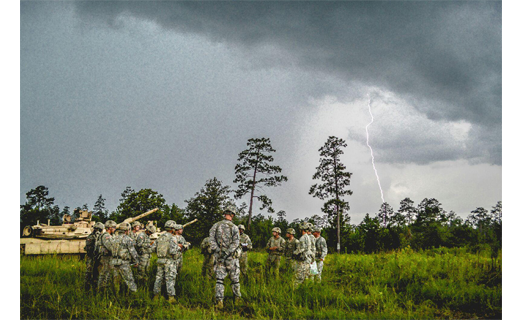
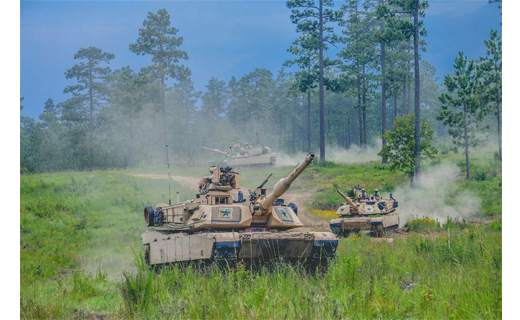
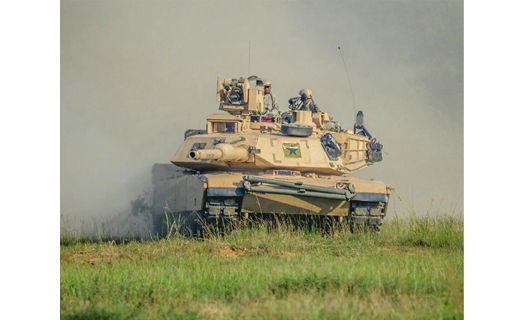
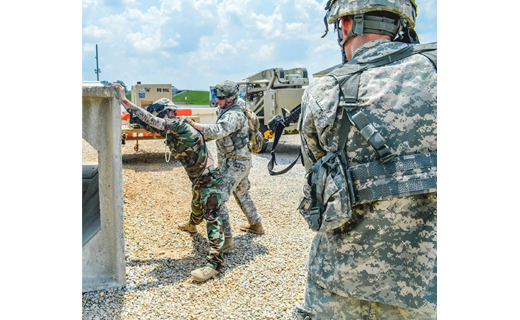
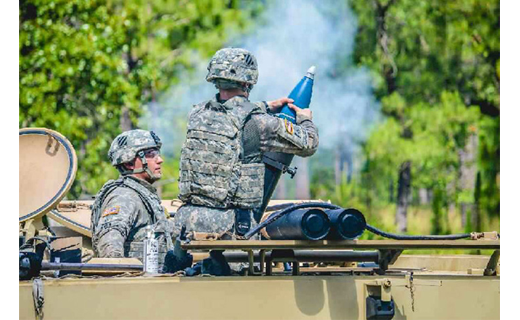
SPC Merrick Harding, 1-64 Armor)
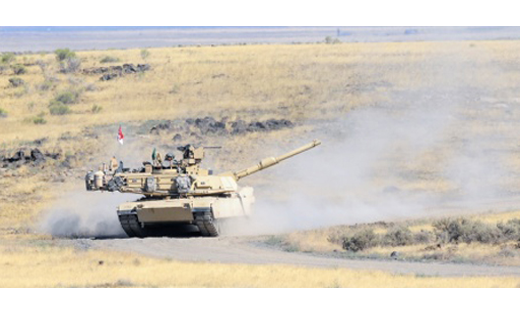
XCTCs, which provide a cost-efficient, time-efficient option for delivering combat-readiness training to Soldiers at or near their home stations, are a chance to train
the way most commanders have always wanted to: free, unrestricted and with more than adequate resources. They are also a chance to solidify AC/RC partnerships. (Photo by SGT Leon Cook, 20th Public Affairs Detachment)
With the successful conclusion of a combined Reserve Component (RC) and Active Component (AC) combat training center (CTC) rotation, the Army Total Force Policy (ATFP)1 has a major victory on its path toward being fully manifested. The training event, clearly replete with intrinsic value, was in fact the seed of something much greater: the initiation of a partnership joining Active and Reserve components into a singular force.
Background
In May and June 2014, 2nd Brigade, 3rd Infantry Division’s 1st Battalion, 64th Armor Regiment Desert Rogues slugged it out with Tennessee’s 278th Armored Cavalry Regiment (ACR) Sabers at Camp Shelby, MS, as part of Exportable Combat Training Center (XCTC) Rotation 14-02. The exercise was a proof of principle for multi-component integration and 278th’s annual training (AT). The results were exceptional, resulting in both units being undeniably better trained for war. We will highlight the tremendous benefits of this experience in this article as lessons-learned to be shared among the force.
This article views the XCTC from the lens of the AC, specifically 1-64 Armor, a combined-arms battalion. The brigade combat team (BCT) partnership program sees 28 National Guard (NG) BCTs partnered with 20 AC BCTs. Of the 20 AC BCTs, 50 percent are either armored BCTs (ABCTs) or Stryker BCTs, who will glean directly applicable lessons from this article. Regardless of the BCT type, however, most of the lessons-learned and best practices are universal.
XCTC is not a new training model; the XCTC concept and application have been around since 2005.2 The difference in this particular event was the 278th commander’s directive to train in the decisive-action training environment (DATE), which necessitated a mechanized/motorized opposing force (OPFOR) not easily replicated by contract support. This necessity fashioned an opportunity to fully meld the AC/RC in a premier training event. This particular mission set created a window where we were able to see the XCTC’s genesis and to plan for future opportunities.
Lessons learned
Lesson 1: Use the Army Synchronization and Resourcing Conferences (ASRCs) to seek out XCTCs for your formations early and do not be confined by the “partnership patch chart.” Early planning enabled through ASRCs will create the greatest situational understanding, allow the greatest level of synchronization for AC and RC stakeholders and enable both parties to exploit the greatest number of training opportunities. Division operations officers and mission-support-element G-3s should not underestimate the value of XCTCs for tactical-level units. As the ATFP expands and evolves, OPFOR troop lists for partnered NG brigades may not be able to be fully resourced by their doctrinally aligned partner AC BCT. G-3s should seize opportunities to “round out” troop lists for XCTCs for divisions whose BCTs cannot fill the requirement.
In recent history, 1-64 Armor has not deployed to Camp Shelby and was therefore wholly ignorant of this regional training center’s massive capabilities across virtually all the warfighting functions.
Lesson 2: Widen the range fans for your training event beyond the XCTC script and sharpen your mission-essential task list (METL) skills. As the name implies, XCTCs will not occur at the “dirt CTCs.” XCTCs will occur, for the time being, at RC regional training sites such as Camp Shelby Joint Forces Training Center in Mississippi and Camp Atterbury Joint Maneuver Training Center in Indiana. AC units are not subject to limitations on the number of allowable training days, as RC units are. AC units should arrive early and exploit training opportunities resident at these highly capable training sites.
The 1-64 Armor, for example, was able to conduct gunnery-skills test training and gunnery Table I using a Camp Shelby motorpool; unstabilized gunnery for the scout and distribution platoons; rifle-squad Tables I-VI; gunnery Table II for one tank and one mechanized infantry company; and tank-gunnery sustainment training using the Mobile Advanced Gunnery Training System in the week before the XCTC. Other resources available at Camp Shelby that 1-64 Armor did not have an opportunity to use, but which illustrate other significant capabilities at locations such as Camp Shelby, were the Medical Simulation Training Center, Close-Combat Tactical Trainer and a multi-purpose range complex, to name a few. Units need to understand that XCTCs will occur during AT periods and training centers will be very busy with other units, so coordinate early. The bottom line is that AC units will seldom have such nearly uninterrupted time “away from the flagpole” to exploit such a myriad of resources; make the most of it and be aggressive!
Logistic lines of communication will be a major concern for any unit operating more than 300 miles (average cruising range and one-day planning factor for the M1088 tractor-truck3) as it plans how it will sustain itself. Camp Shelby is about 550 miles from Fort Stewart, GA. With only one organic battalion (-) in the field, daily military long-haul for resupply was impractical.
Lesson 3: Take required classes of supply and sustainment enablers and identify local assets, too. Our parent brigade, 2 ABCT (Spartans) set up our battalion for success in several ways. First, the brigade-support battalion (BSB) deployed a support-operations officer (SPO) liaison with our pre-deployment site survey (PDSS) team. This lone Army captain paid huge dividends and laid the foundation for what was a well-resourced mission as he gained the initial understanding of what Camp Shelby could provide sustainment-wise. His personal reconnaissance formed the basis for our concept of support. As an example of what units may have to plan for, we deployed one entire container of Class III package products (petroleum, oils and lubricants) to ensure effective operation of our equipment.
Second, based off the type of formation we are and the vehicle density we enrolled on the Deployment Equipment Listing (20 M1A2SEPV2, 27 M2 series family of vehicles, five M88 Hercules and two M1064 mortar carriers – about 3/5 of the battalion’s total rolling stock and many containers), our parent brigade and BSB (26 BSB) provided us with two critical assets. We received a “Supply Support Activity (SSA) Forward” Class IX sustainment package housed in an M1087A1 that consisted of 113 lines of property and line replaceable units (LRU) totaling $3,165,690.19 dollars’ worth of property. During our rotation, we consumed $523,708.22 dollars’ worth of the SSA Forward, resulting in 17 vehicles repaired.
The other critical asset was the Direct-Support Electronic Test Set (DSETS) van and a two-Soldier team that 26 BSB deployed with us. The DSETS team was another homerun as they repaired 29 LRUs over 30 days, resulting in 20 pacing items repaired.
We would not have been able to sustain 278th ACR’s training without both these assets.
Third, our forward-support company (FSC) commander and the BSB SPO shop designed a unique parts-delivery arrangement using a system of scanned purchase requests and FedEx. Purchase requests were generated forward, signed by the battalion commander and/or the battalion executive officer, approved by the home-station brigade, resourced from SSA Rear or Forward, and then processed for shipment via FedEx from Fort Stewart to Camp Shelby. Using this system, we received 14 push packages (combination of one freight shipment and 13 overnight shipments), resulting in 26 pacing items repaired. The one improvement we would offer to this system is to make it available over weekends and holidays when home-station installation activities are closed but deployed units are still training and generating logistics requirements.
Under the theme of “identify local logistic enablers, too,” we did not fully exploit a key asset: the Maneuver Area Training and Equipment Site (MATES). MATES – which was established to preposition selected pieces of combat and tactical equipment – provides assets to units conducting AT and inactive-duty training at Camp Shelby.4 MATES are found on many NG training sites.
In essence, MATES is akin to the blue and gold fleets from National Training Center days of old. The fleets are not unassigned equipment; rather, certain RC units are “donor” units whose stored equipment, with proper coordination, can be requested using a Forces Command (FORSCOM) 156-R form. With proper coordination, equipment can be signed for to support a unit rotation, and reimbursement may be achieved through the use of a DD448 form, the Military Interdepartmental Purchase Request.
MATES have an exceptional level of maintenance capability that units will likely need to call upon. Depending on where units train, MATES may offer other services, too. Some sites allow units to sign for property ranging from OE-254 frequency-modulation communications antennas to ground-mounted machineguns to M1 tanks. Some sites allow units to conduct maintenance training on site, side by side with MATES personnel. The point is, as part of a units’ planning and PDSS, a visit to the MATES to meet the superintendent is a must.
XCTC was a genuine deployment for 1-64 Armor. We deployed 203 items consisting of 168 pieces of rolling stock and 35 containers, 500 Soldiers, two field-service representatives and one logistics-assistance representative. We used multi-modal systems of deployment, including air, rail, bus and line-haul.
Lesson 4: Train special teams in advance, rehearse critical home-station deployment events and engage relevant home-station deployment points of contact early in planning. To deploy successfully, the single capability units can’t do without is the unit-movement officer (UMO). Go beyond just having a single UMO; create as much depth as you can. We used an S-3 liaison-officer (LNO) lieutenant and our fire-support officer as the battalion UMO team (both were school-trained). One seemingly small issue such as a frustrated Forward Repair System will temporarily consume one UMO; having two dedicated UMOs maintains momentum. Companies must have at least one UMO but should try to have two.
Early on, we requested that a brigade LNO be assigned the XCTC mission as our link to the division and installation. Immediately, the LNO established two critical linkages for the battalion. First, he got the brigade movement officer abreast of our requirements, who in turn built our strawman deployment timeline and communicated our requirements to the Division Transportation Office (DTO) and the installation’s Unit Movements Branch. Getting division and installation visibility on our mission well in advance proved vital and eliminated almost all last-minute turmoil. Lastly, the LNO actually deployed with the unit (keeping the Spartan brigade abreast of our requirements), developed branch plans and facilitated redeployment.
The DTO performed analysis and determined that it would actually be more cost-effective and time-efficient to contract rail-load operations on the near and far end. As a result, once vehicles arrived at the rail-marshalling areas (RMA) at Fort Stewart and Camp Shelby, rail upload and download proved to be an anti-climactic non-event.
The two highest-payoff home-station events were the scaled deployment exercise (DEPEX) and the subsequent movement-preparation activities (MPA) operation. The DEPEX was scaled due to time. We were not able to perform a full load-out, but we recommend doing so if time is available. We loaded out one type of each vehicle and one type of each container to proof systems, test UMOs and build reliable deployment-planning factors. Each company had load-out requirements that, again, tested and trained UMOs, and identified to battalion UMOs where they would have to place more emphasis. The DEPEX addressed the overall deployment sequence – including pax manifesting and verifying bus rosters – and therefore included a rehearsal of the critical MPA operations.
The MPA operation preceded movement to the RMA and was done according to 3rd Infantry Division’s deployment handbook/standard operating procedure. Institutionally, we had not performed this type of event in many years; the requisite skills had atrophied badly, and for many personnel were non-existent. The use of the multi-station MPA process greatly reduced the number of frustrated vehicles at the RMA and, again, made RMA operations an anti-climactic event.
As part of the deployment sequence, companies were “missioned” to perform specific critical tasks. The FSC, for example, had responsibility to run the MPA. Company C ran RMA operations at Fort Stewart, and Company D ran RMA operations at Camp Shelby. This enabled the battalion to maintain focus on the big picture while the companies ensured smooth operation of individual steps in the sequence.
Units that fail to deploy do not fill the annals of history. Those annals may be filled with units that failed to deploy smoothly and deployed with extreme frustration, but generally speaking, we all make it to the fight – eventually.
Lesson 5: Heed Lesson 4 so you can focus on the reason you are going to XCTC in the first place: to build combat skills and readiness. The commander was very concerned that, due to the lack of institutional knowledge on conducting this sort of deployment, we would have major issues with the deployment sequence. Therefore, we focused an inordinate amount of energy in this area – at the expense of solidifying and preparing for our “box” training objectives. Do not underestimate the level of concurrent activity that Army formations can sustain. Battalion-sized elements can easily do five things at once – and do them well. Our deliberate shift to intensely focusing on the training objectives came too late and resulted in delayed achievement of advanced-level tactics.
Lesson 6: Request First Army observer-coaches/trainers (OC/T) to get the most from your training. It is an old adage in the Army that training that is not observed is not training. For an XCTC, there is no reason for that to occur. First Army has a robust and highly capable contingent of OC/Ts. We were outfitted with a complement of sergeants first class and captains assigned to all our companies and platoons. Their focus on the fundamentals of doctrine and obvious grooming as OC/Ts significantly increased our training progression.
Tactical lessons
Over the course of 30 continuous days of operations in a DATE environment, we identified many tactical lessons-learned. Following are just a few.
Mission command: Troop-leading procedures (TLP) are a highly perishable skillset; repetition is the key to success. TLPs started at extreme sub-par levels but rapidly improved due to repetition and OC/T coaching, with one notable enduring shortfall. Unlike traditional “dirt CTC” rotations, the XCTC’s pace was not as extreme and allowed just enough time between iterations/lanes to train TLPs correctly. This thoughtful exercise-design model proved critical in allowing platoon leaders an appropriate amount of time to “re-do” TLPs and “see what right looks like first” to prepare quality orders while progressively refining operations-order (OPORD) delivery techniques.
What we never fully achieved was the use of platoon standardized hard-copy pre-formats for OPORDs. The use of platoon formats down to tank-commander and squad-leader level allows the platoon leader to give his finished order to his subordinates, who can then copy it down on their pre-format prior to the actual order. Then, during the OPORD, instead of furiously trying to copy the OPORD (and missing large portions of it and the intent), subordinates can actually pay attention to the platoon leader’s words and movements as he briefs and indicates key locations on the sand table, map, etc.
Mission command: When you tell company-level leaders to “focus on TLPs,” specify which step; we selected the warning order (WARNO) and OPORD. Our assessment was that the crucial step in TLPs was the WARNO. The WARNO is your first and best chance to achieve parallel planning, which in turn enables doctrinally correct pre-combat checks as well as the initial understanding of mission variables. Next, we assessed that the order itself, “the plan,” was the second most important step. Either the OPORD is the foundation of mission success, or it is where the train starts coming off the tracks – depending on its quality and delivery. Lieutenants need massive repetition to become expert at this skill, but the one real nugget we (re)discovered is an old one: keep the plan simple. If no one can remember the plan, there is no plan.
Mission command: Use doctrinal principles to frame operations first; the troops on the ground will figure out the tactics, techniques and procedures (TTPs) on their own. First Army trainers were extremely helpful as they coached during hotwashes and after-action reviews. Before conducting a defense, avoid letting leaders delve into the TTPs of building target-reference points, decoys, etc. Instead, teach them first to consider how their plan will address the characteristics of the defense (disruption, flexibility, maneuver, massing effects, operations in depth, preparation, security and synchronization); the TTPs will come after that. In other words, don’t pick curtains for a house that isn’t built yet.
Mission command and intelligence: Leverage old and new technology to get the best picture on the ground. Young leaders with experience in Iraq and Afghanistan have become adept at employing imagery to provide precise views on objective areas and to assist in conducting intelligence preparation of the battlefield. Sustain this tactic but combine it with the requisite Military Grid Reference System (MGRS) maps that enable controlled movement into the objective area and accurate calls for fire. When possible, make this the map set on Blue Force Tracker (BFT).
Regarding maps, we saw initial resistance to making use of detailed graphic control measures (GCM) on MGRS, imagery map sets and BFT. GCMs are vital for controlling and synchronizing forces, describing the situation to higher echelons and enabling fire distribution and control. Graphics became a reportable and inspectable item.
Mission command and sustainment: Use the Combat Service Support Automated Information System Interface (CAISI) to increase your efficiency and timeliness of logistics reporting. We did not employ our CAISIs but wish we had. Our logistics reporting was essentially done using old and drawn-out processes of sending reports back with the daily logistics packages. If units do not employ their CAISIs, they are accepting the condition of no digital connectivity between battalion- and company-level command posts (CP) except BFT. Battalions possess only one CP node (CPN) dedicated to the main CP and one Very Small Aperture Terminal dedicated to the Standard Army Maintenance System clerks. It is essentially implied that either your other nodes (combat-trains CP (CTCP), unit maintenance collection point, etc.) will either be consolidated with the main CP and will leverage the battalion’s CPN for digital connectivity, or they simply won’t be able to use the Army’s Warfighter Information Network-Tactical (WIN-T). Using the CAISIs alleviates this and enables companies and other entities such as the S-1, S-4 and medical platoon to leverage WIN-T and tap into systems like Electronic Military Personnel Office, Battle Command Sustainment Support System and Property Book Unit Supply Enhanced. A battalion not using CAISI directly erodes – or at least delays – BCT-and-above situational awareness and understanding of subordinates’ needs and status.
Mission command: With the advent of the FSC, the role of the headquarters and headquarters company (HHC) commander is largely undefined in a DATE scenario. Determine a role for your HHC commander early so he/she understands his/her task and purpose and how he/she enables the battalion. Prior to modularization, the field-trains CP was the HHC CP, and the HHC commander provided the oversight for logistics from the brigade-support area to the combat trains. Now the FSC commander is clearly the best choice to perform this task, and the battalion essentially has an extra company-level CP and commander to employ as the battalion commander sees fit. The HHC commander, in our case, was used to provide oversight for the CTCP and to supervise the training of the scout platoon and sniper section. But the real lesson is that the role of the HHC commander will not be fixed; what we did was based off mission-specific factors, not a doctrinal model.
Final lesson: Make the XCTC experience a means to an end, not the end. Our goal is to use the relationships we built with 278th ACR at Camp Shelby to serve as a springboard for a true, lasting partnership. Our goal moving forward is to attend leader-professional-development sessions together, enable subsequent RC AT, share TTP, establish recurring touchpoints and develop long-range training calendars that see integration of each other’s key events. For our part, we are already working to see how we can integrate into an upcoming 278th warfighter exercise. In short, quoting former FORSCOM commander GEN Daniel B. Allyn, “The key is to leverage our collective leadership capacity to make us all better.”
XCTCs will most certainly change in the future; the Army is always changing. Clearly, though, this is a major opportunity for all parties involved – that fact is not changing. XCTCs provide a chance to train the way most commanders have always wanted to: free, unrestricted and with more than adequate resources. It’s a chance to solidify our AC/RC partnerships, and it’s a chance to build overflowing confidence at the individual Soldier and platoon level. It’s a chance to be better prepared for war.
Notes
1Secretary of the Army, 2012.
2SRI International, 2014.
3Federation of American Scientists, Military Analysis Network, 1998.
4Mississippi National Guard, 2010.
 email
email print
print